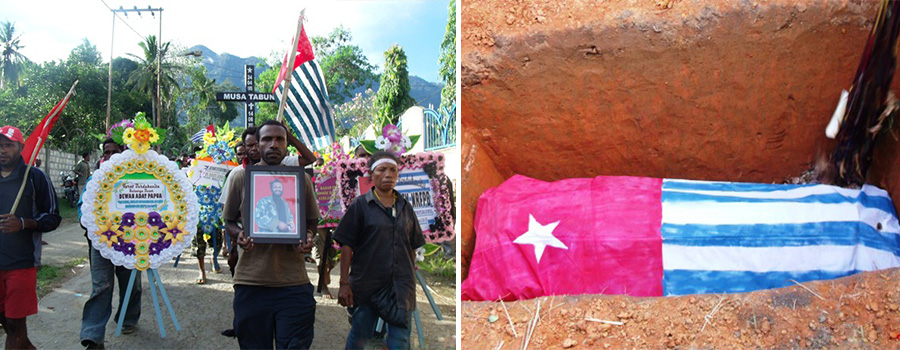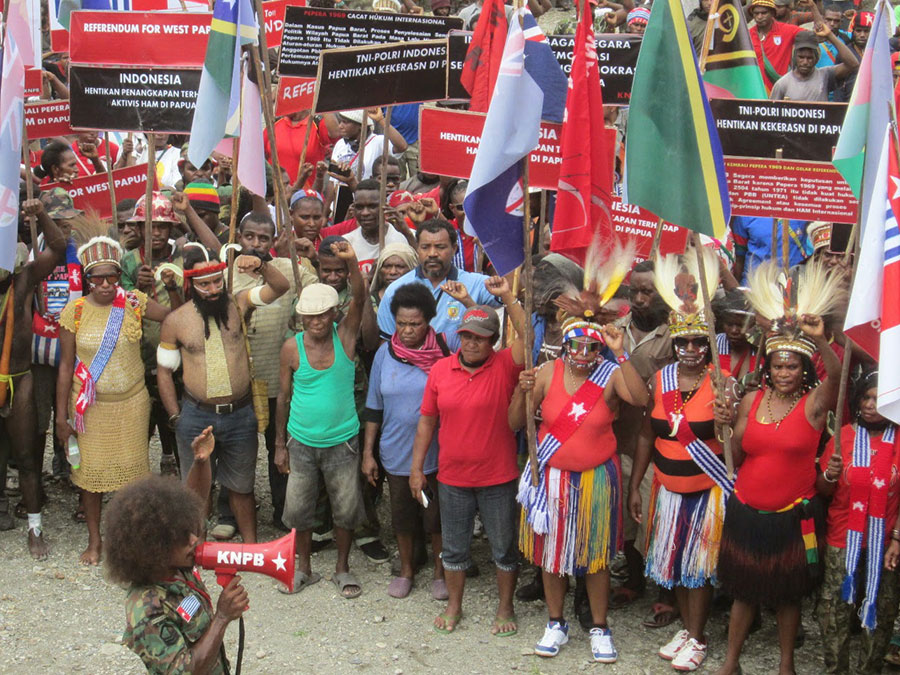
After Indonesia’s reformasi, which was reported on by international observers, the world tends to believe that Indonesia is reborn as the world’s third largest democracy. The blanket label has swept serious allegations of human rights violations under the carpet. In November 2001 the Papuan leader, Theys Hiyo Elluay, was kidnapped after an official dinner with the commandant of the Indonesian army special forces in Jayapura. A few days later, his body was found in the vicinity of Jayapura. The investigation team, which was established by the then President Megawati, found evidence that the army’s Jayapura-based special forces Kopassus was responsible and four soldiers were convicted and sentenced to three and three-and-half years in jail. While Aristoteles Masoka, Eluay’s driver, remains missing, the Commandant Hartomo was recently promoted to the military’s Strategic Intelligence Agency (BAIS). 1
Into the scene
In June 2012, a young Papuan activist, Musa Mako Tabuni, was shot by a group of plain clothed-police of Jayapura in the vicinity of the city. He was alive when he was taken to the Jayapura police hospital but various witnesses confirmed that he was left unattended until he died as the police prevented doctors from administering proper medical treatment (International Crisis Group 2010: 7; Koalisi Masyarakat Sipil untuk Penegakan Hukum dan HAM 2012). None of the police officers, however, have been held accountable. The police believed that Tabuni was responsible for shooting incidents in Jayapura that also wounded a German tourist.
Not long afterwards, on the eve of the visit of President SBY to Papua in 2014, the body of Martinus Yohame, a young Papuan leader of Komite Nasional Papua Barat (KNPB/ the National Committee of West Papua), was found floating off shore near the city of Sorong. The body was tied with his hands and legs inside a plastic rice bag and weighted with heavy rocks to drown him. A few day earlier, he organised a press conference that expressively rejecting the visit. KNPB believes that the Indonesian state security services were responsible for the murder. As a result, the Indonesian National Commission on Human Rights (Komnas HAM) insisted that the police had to conduct investigation. The investigation, however, went nowhere when the family of the victim refused an autopsy so that Komnas HAM was unable to collect evidence. 2

We should note that these cases did not occur during the Suharto authoritarian regime (1967-1998) but under the democratic regime of Indonesia. The killings exemplify the way in which the Indonesian state apparatus controls the life and death of their own citizens who were perceived as a threat to its sovereignty. They might have been labeled as the enemy of the Indonesia state so they were eliminated in a brutal way. Eluay, Tabuni and Yohame shared a common passion: a passion for justice and freedom. Instead of democracy that believes in the rule of law, they had confronted what Achille Mbembe (2003) refers to as ‘necropolitics.’ That is, the politics that justify the ways in which the state assumes, controls, and exercises the sovereign right over death and life of its citizens.
Notwithstanding a long history of political killings in the Indonesian historiography, such as the 1965 massacre (Cribb 2001; Gerlach 2010; Roosa 2006), in this article, however I will solely focus on the killings of a few leaders of KNPB. The selection is not meant to devalue some 40 other KNPB activists who have been killed by the Indonesian authorities in the last eight years. 3 Rather, I will reflect on the acts of targeted killing of the Indonesian state security against a few young Papuan leaders in order to fathom the question put forward by these young Papuans: “Mengapa Indonesia bunuh kami terus?” (Why does Indonesia continue killing us?).
What is Komite Nasional Papua Barat?
Established on 19 November 2008 in Sentani, Jayapura, by various organisations and Papuan activists, 4 KNPB has grown quickly as an organisation of the Papuan youth that publicly campaigns for a referendum for Papua because they believe that the first referendum or the so-called ‘the Act of Free Choice’ in 1969 for Papuans was flawed. In their view, which is independently confirmed by historians (see Drooglever 2009; Saltford 2003), the Act of Free Choice paved the way for the Indonesian state to take over and oppress Papuans. Given this standpoint, KNPB remains not so convinced that the idea of dialogue with Jakarta as promoted by Indonesian Institute of Sciences (LIPI) and the Papua Peace Network since 2009 would be an effective medium to address the historical justice. At some stage, KNPB tried to interrupt a public consultation organised by the Papua Peace Network. 5
In KNPB’s early rallies in 2012, some local journalists, including the leading Papuan journalist, experienced intimidation from KNPB. 6 The coordinator of Independent Alliance of Journalists (AJI) of Papua expressed its disappointment with the incident.

Given this background, it is not surprising that many people, including the state authorities and international observers, such as the International Crisis Group, portray this group as ‘militant’ (2010: 1). Further, the Brussels-based think-tank suggests “This group may be responsible for some of the incidents in and around the provincial capital Jayapura and some of the violence around the 2009 elections” (2010: 1) but the report does not offer any evidence to support the bold statement. In my response to the ICG report, I explain that this description is misleading and inadequate (Hernawan 2010). “They never meet us,” confessed the General Chairman of KNPB. 7
During the 2014 Indonesian national election, the group organised public rallies in major cities of Papua and called for a boycott of the election. 8 Although the call was not particularly effective as most Papuans went to the ballot and voted Joko Widodo for the Indonesian president, the call defies the cornerstone of Indonesia’s democracy, that is, the general election. It also illustrates the ways KNPB refused to engage in the Indonesian political system.
In the last few years, KNPB has transformed itself. It no longer presents itself as a group of young noisy Papuans on the street but has become one of the co-founders of the most important Papuan political organisation at present: the United Liberation Movement for West Papua (ULMWP) under Saralana Declaration 9 of 6 December 2014 (Hernawan 2016). This organisation was granted observer status at the Melanesian Spearhead Group, a sub-diplomatic forum in the South Pacific, during its 2015 Summit in Honiara, Solomon Islands (Hernawan 2015).

Why does Indonesia kill us?
Although the Papua’s KNPB is not an armed group which uses violent means, the state response has been brutally excessive. Given the background of their grievances, the questions whether KNPB leaders deserve such brutal deaths. It seems that the law has been suspended when it comes to those that might be deemed enemy of the state.
The killing of Mako Tabuni was different from that of Martinus Yohame, the head of Sorong branch of KNPB. Tabuni was shot in public whereas Yohame was stealthily killed. His body was found floating in a sack at sea. While the former was publicly assassinated by the Indonesian police, the perpetrator of the latter killing remains unknown. While Tabuni’s killing shows the theatrical brutality of the state, Yohame’s body was suppressed into non-existence.
In both cases, however, we notice that the law has ceased to function. It is powerless to penetrate the power of necropolitics that spreads death. If we juxtapose Tabuni and Yohame’s cases with the cases of Munir and Eluay, we will find commonalities. Their broken bodies have been made a medium to transmit the message of the sovereign to the broader audience. Therefore, killing is not an end in itself. Rather, it is carefully designed to infuse a message of terror among the targeted community, the Papuans.
Interestingly, in contrast to Mbembe’s prognosis, the KNPB and the Papuan body do not surrender to the domineering power of the Indonesian state. Rather, they turn their destroyed bodies into a medium to transmit the message of resistance as formulated in KNPB’s memorial for Yohame:
“Hi Indonesia the coloniser, Budi Hernawan REFERENCES Cribb, R. 2001, ‘Genocide in Indonesia, 1965–1966’, Journal of Genocide Research, vol. 3, no. 2, pp. 219-39. Notes:
You can kill my body but my soul and spirit are with the eternity
It has been inscribed in the history of the struggle of Papuans forever.” 10
(Lecturer at Paramadina Graduate School of Diplomacy; Research Fellow at Abdurrahman Wahid Centre for Interfaith Dialogue and Peace, University of Indonesia)
Drooglever, P. 2009, An Act of Free Choice, Decolonization and the Right to Self-Determination in West Papua, One Word, Oxford.
Gerlach, C. 2010, Extreme Violent Societies: Mass Violence in the Twentieth-Century World, Cambridge University Press, Cambridge.
Hernawan, B. 2010, ‘Portraying a Threat to a Reluctant Government’, Australia Policy Online, <http://www.apo.org.au/commentary/portraying-threat-reluctant-government>.
—— 2015, ‘Contesting Melanesia: The summit and dialogue’, The Jakarta Post, <http://www.thejakartapost.com/news/2015/07/08/contesting-melanesia-the-summit-and-dialogue.html>.
—— 2016, ‘ULMWP and the insurgent Papua’, Live Encounter, 1 November 2016.
International Crisis Group 2010, Radicalisation and Dialogue in Papua, International Crisis Group, Brussels.
Koalisi Masyarakat Sipil untuk Penegakan Hukum dan HAM 2012, Laporan Investigasi: Pembunuhan Kilat Musa Mako Tabuni Tanggal 14 Juni 2012 di Waena, Jayapura, Papua, Koalisi Masyarakat Sipil untuk Penegakan Hukum dan HAM, Jayapura.
Mbembe, A. 2003, ‘Necropolitics’, Public Culture, vol. 15, no. 1, pp. 11-40.
Roosa, J. 2006, Pretext for Mass Murder: The September 30th Movement and Suharto’s Coup d’État in Indonesia, The University of Wisconsin Press, Wisconsin.
Saltford, J. 2003, The United Nations and the Indonesian Takeover of West Papua, 1962-1969, The Anatomy of Betrayal, First edn, RoutledgeCurzon, London & New York.
